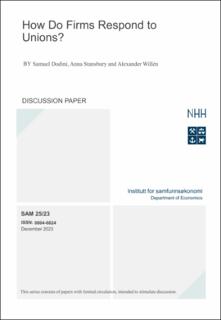How Do Firms Respond to Unions?
Working paper

Åpne
Permanent lenke
https://hdl.handle.net/11250/3109527Utgivelsesdato
2023-12-22Metadata
Vis full innførselSamlinger
- Discussion papers (SAM) [657]
Sammendrag
This paper provides a comprehensive assessment of the margins along which firms in Norway respond to increased union density, using legislative changes in the tax deductibility of union dues as a quasi-exogenous shock to firm-level unionization rates. Despite higher personnel costs driven by a union wage premium, the average manufacturing firm increases employment and scales up production, charges higher prices in the product market, enjoys higher nominal value added per worker, and experiences no decrease in profits. We show that this result is a direct implication of the labor- and product-market power that the average manufacturing firm possesses, in combination with a reallocation of inputs and industry revenue shares from smaller and less unionized firms to larger and more unionized firms. Larger firms are, therefore, increasing employment and output at the same time their ability to mark up prices is growing, thereby preventing negative profit effects. For the broader private sector in which firms do not hold much price- or wage-setting power, we observe the opposite result: the average firm reduces employment and profit falls. We synthesize these findings through a partial-equilibrium model of firm decision-making that incorporates union bargaining, product-market price-setting power, and labor market monopsony power.